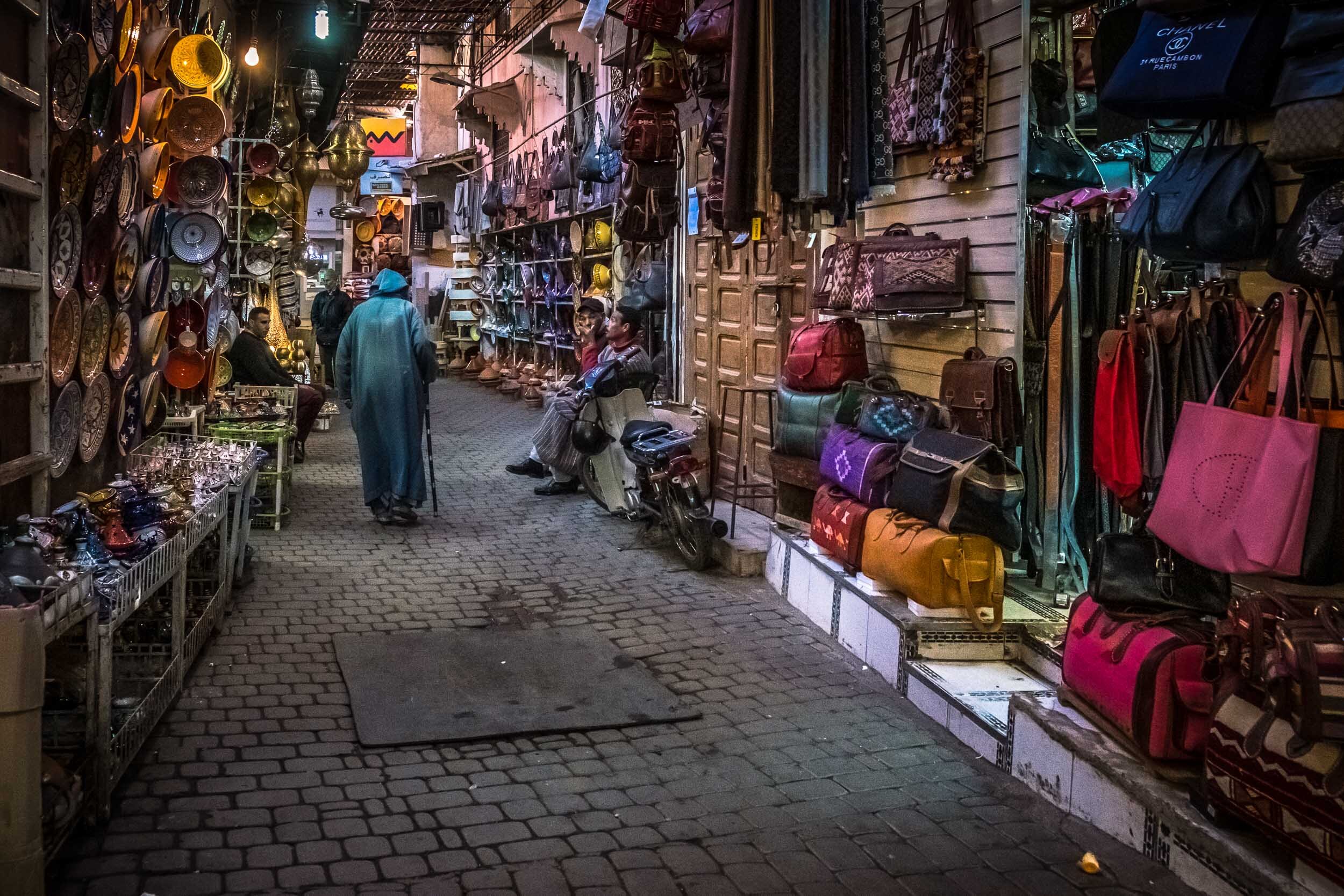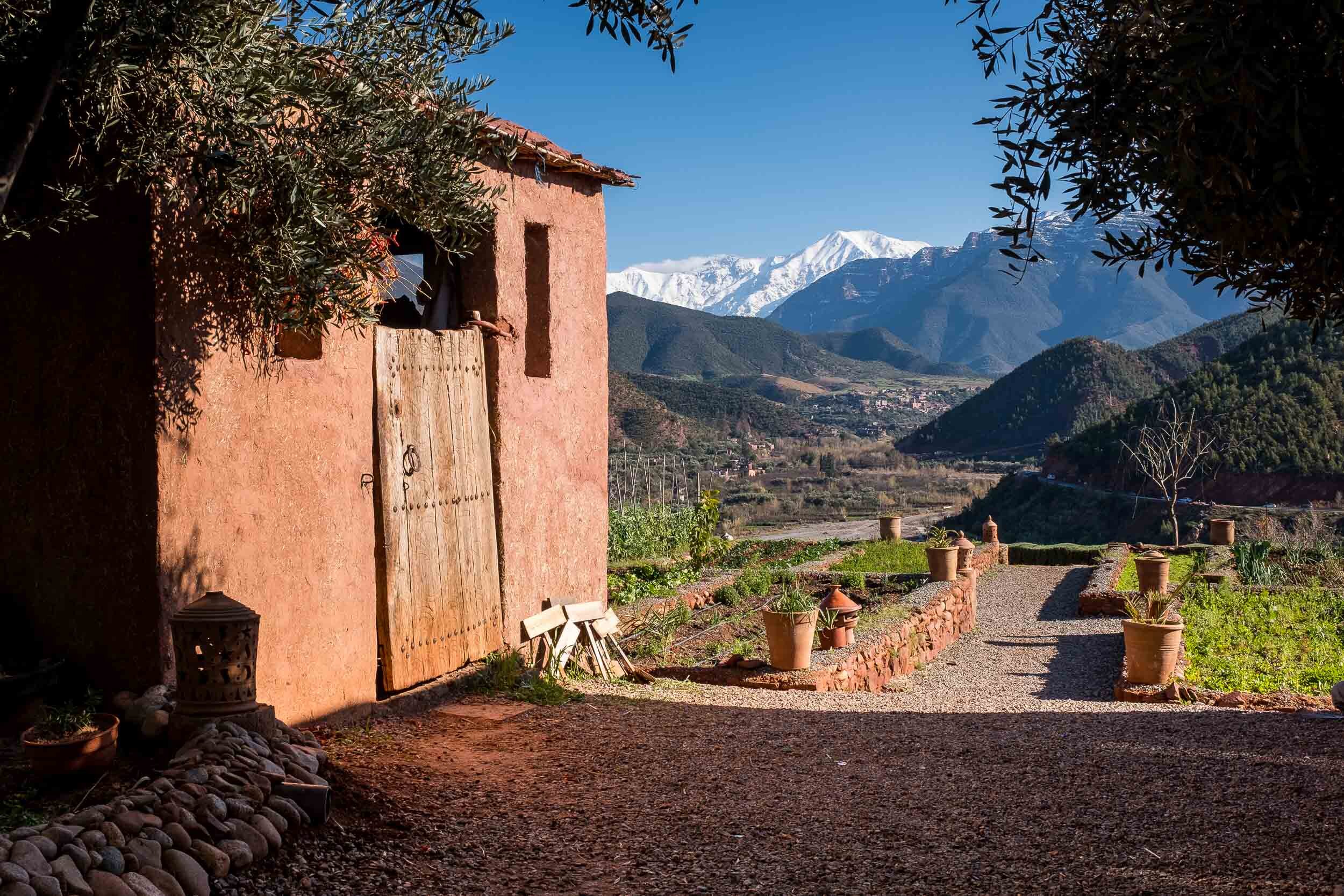Photography in….Morocco
Background:
A 10 day trip to Morocco, with the first half being spent in the hustle & bustle of Marrakesh and the second half up in the calm of the Ourika valley - in the foothills of the High Atlas Mountains.
Undertaken in February 2018, the intention was to capture pictures showing the people and the scenery of two very different parts of Morocco, albeit they were separated by a drive of just 1.5 hours.
1. Marrakesh
On arrival in the city, you’re met with an assault on all the senses. The bright vivid colours, the cacophony of noise (from the muezzin calling Muslims to prayer through to the trumpets of the snake-charmers) and people desperate for your business all vie for your attention. Assuming that you're staying in the Medina / old city, you'll probably need someone to show you the way through the narrow streets and souks through to your 'riad' or lodging as it’s very easy to get lost.
Everyone is very friendly, just be aware, however that some are just looking to show you the way, either to where you want to go, for some dirhams at the end, or to their family's shop where you'll be expected to buy something. Look as though you know where you’re going, and you’ll be fine however hesitate, or consult a map, and there’ll be someone by your side immediately, offering to guide you to where either you want to go - or, occasionally, where they want you to go!
There are two main parts to Marrakesh’s ‘Medina’, the main square - the Jemaa el Fna - and the souks. The former really only comes to life in the late afternoon and evening, once all the food stalls have been set up and people gather to eat supper. It is, generally, easy to find, either by looking out for the tower of Koutoubia mosque or following the signs around the souks which direct you there. If all else fails, it's better to ask a shopkeeper, rather than a passer-by!
People at a food stall in the Jemaa el Fna / main square
In the Marrakech souk
The souks, and there are a number, are generally covered, connected by little alley-ways through which men in bicycles and mopeds thread their way through the throng of people, and others push their carts of produce and merchandise, replenishing their stalls. Both the range and the quality of the merchandise on offer varies significantly
Photography in Marrakesh
The souks, markets and the main square (Jemaa el Fna) are all crying out to be photographed, as are the individuals that make up this lovely city.
Be aware, however, that many of the locals prefer not to be photographed – and they’re not shying away looking for a tip either. While the tourists flock to the old markets, there are many locals who live and work here, and they understandably don’t appreciate a camera in the face.
Many people discover that taking pictures in Marrakech is harder than anywhere else in Morocco. My own opinion on why this is, is due to saturation - there are so many tourists that it can be very overwhelming to be photographed multiple times a day.
So, if you do still want to capture some of the life here, set the camera to silent mode (if it has one), use a wider angle lens, zone focus at 2 metres, set your aperture to f8 and shutter speed to 1/250 (or 1/125 if you're inside the souks) and you should be able to get some good photographs.
I did get 'caught', once, the stall holders in the souk very carefully watch anyone who's obviously a tourist - and one (a young guy, and more alert that the older ones) saw me surreptitiously taking a photo of him and his stall as I walked past him. He asked to look at the photo, which I showed him - then that I delete it, which I did, out of respect to him. I then walked on, no damage done to either party.
Another word of warning - don’t take photos of the monkeys on chains or the snakes being charmed in the main square unless you’re willing to pay a hefty sum for the privilege of doing so. Even if you do so surreptitiously, the owners have people mingling in the crowd and, as happened, to a friend, call them out, asking for money.
On this note also be careful of taking obvious photos of the stores as the owner may try and make you pay or buy something for doing so.
One one occasion, we were taken into the fabrics / wool dyeing area of the souk, rather reluctantly, however, my wife did end up buying with a couple of lovely scarves, for a perfectly reasonable price, after she held her ground on what she was prepared to pay, and I had free rein to photograph the dyeing process - which made for some good photos albeit the working conditions were pretty grim!
A person showing the dyes used in wool dyeing
A worker dyeing wool in the Marrakech souk
After we left Marrakech, I discovered that a local tour company, Travel Link, runs half day ‘Photography in Marrakesh’ tours. Looked to be a good way of getting photographs without all the usual hassle and particularly useful if you've limited time in the city.
Hints:
1. Take lots of small 10 and 20 dirham notes (c£0.75 / £1.50) and be ready to hand these out in exchange for photos of help in finding your way around, or out of the souks
2. Be prepared to buy things that you hadn’t initially intended to do - we ended up with a couple of lovely scarves, and some nice photos.
3. Just relax, embrace the spirit of the place, and
4. Takes lots of photos
2. The High Atlas Mountains
The Ourika Valley is just 90 mins drive from the centre of Marrakech and a totally different experience - quiet, calm and peaceful with stunning scenery (Africa’s second highest mountain, Mt / Jebel Toubkal, (4,816 metres high) is located here) and friendly Berber villagers.
Despite the fact that we were there in the second half of February, the weather was surprisingly warm (definitely t-shirt weather) in the sunshine however the temperatures dropped rapidly when it clouded over. When it rained, and it did a couple of times during our trip, it rained heavily and persistently.
Up here, we did a couple of guided walks. One the first, through the National Park, I discovered that there was a problem with my SD card - when trying to show a Berber villager his photo. I should have been making use of the second card slot of my X-T2 as a back-up fortunately I had been backing up my cards each evening on a WD My Passport Wireless drive (via its SD slot) and so was able to recover the images I'd taken previously.
During the walk, we had lunch in a Berber village, the owner and his wife were happy for us to photograph them - indeed, 10 years ago, they’d featured in a book on the area. Such a different experience to that in Marrakesh. At the end of our lunch, we left Madame with a pack of pens to be given to the village school for the benefit of the children, something that the adults appreciate
Aisha & Brahim Ait El Kadi, in their house in Taourirt, Morocco
On another walk, this time through villages up the valley and back along the river, we encountered a few people. Generally speaking, it’s OK to photograph the men if you ask for permission however less so the women and children. There have, apparently, been instances of Moroccan men photographing women and/or children and then for these images to appear in the shops and souks of Marrakesh.
3. Summary / Conclusions
Morocco is a wonderful place to visit, everyone is very friendly, it’s easily accessible from Europe and there’s a wealth of material to photograph. However, the countrywide concern, which is particularly prevalent in Marrakesh, about photographing people, makes it very difficult to get good ‘travel' or 'street' images. That said, it's not impossible, it just requires a little more thought, and care, that it would do in most other cities.
Gear:
After some consideration, I decided to take the following:
> Fuji X100f and WCL100 wide angle converter, for use around the Marrakesh souks and streets, with the camera’s fixed 23mm (full frame equivalent 35mm) and the ability to go out to 19mm (FFE 28mm) using the converter.
> Fuji X-T2 body with the 18-55mm walk-around lens, 10-24mm wide-angle (for the interiors) and the 55-200mm telephoto for the land- / mountain-scapes
> Filters (Lee Seven5 series) and a tripod for evening or early morning use in the mountains - only used once.
> WD My Passport Wireless drive - using its SD card drive to back up images at the end of every day. This has now been superseded by their My Passport Wireless Pro.
During the week and across both locations, I used the following lenses:
10-24mm: 6%
18-55mm: 60%
55-200mm: 7%
X100f / 23mm: 16%
iPhone: 11%
Other hints:
> Next time I would considering booking a photography tour with a local guide, who can both speak the languages (Arabic, Berber and French) and deal with the financial side of taking pictures in the souk, as well as knowing his way round them. This latter point is particularly the case if your time in the city is limited.
> The souk, in particular, is narrow and, generally, very busy, so don't use a large rucksack to carry your gear around with you. I just had a simple canvas bag, 1 additional lens, map and bottle of water - didn't attract any attention or get in the way.
> Whilst in Marrakesh, make sure that you visit the recently opened Museum of Photography which has a collection of over 4,500 old photographs, covering the period 1870-1950. It highlights the origins of photography in Morocco, with works by the early photographers who worked there, including George Washington Wilson, A. Cavilla and Marcelin Flandrin.
> Even if you think that, in taking a single memory card out with you, that you have sufficient memory for the day’s shooting, bear in mind that you could have problems with your card, as I did.
> Don't rely on being able to buy photographic equipment in Marrakesh - and certainly not in the High Atlas, take everything you're going to need with you.
> Take pencils or crayons to give to the mountain guides for the school children, they'll appreciate your visit even more.
> Bear in mind that WiFi is going to be limited outside of the main cities, so don’t rely on using this to back up images.
> A warning for anyone with a drone - don't take one with you. I was told by our guide that these are forbidden in Morocco, they are confiscated and fines imposed on anyone bringing one into the country.
I hope that this has been helpful - any queries or comments, please let contact me here - or via the Contact page.
May - 2018












